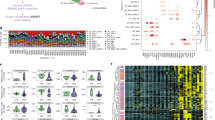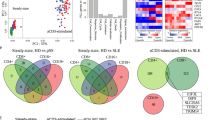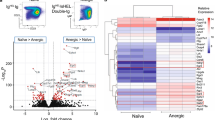Abstract
Tolerizing mice polygenically predisposed to lupus-like disease (NZB/NZW F1 females) with a peptide mimicking anti-DNA IgG sequences containing MHC class I and class II T cell determinants (pConsensus, pCons) results in protection from full-blown disease attributable in part to the induction of CD4+CD25+Foxp3+ and CD8+Foxp3+ regulatory T cells. We compared 45 000 murine genes in total white blood cells (WBC), CD4+ T cells, and CD8+ T cells from splenocytes of (NZBxNZW) F1 lupus-prone mice tolerized with pCons vs untreated naïve mice and found two-fold or greater differential expression for 448 WBC, 174 CD4, and 60 CD8 genes. We identified differentially expressed genes that played roles in the immune response and apoptosis. Using real-time PCR, we validated differential expression of selected genes (IFI202B, Bcl2, Foxp3, Trp-53, CCR7 and IFNar1) in the CD8+T cell microarray and determined expression of selected highly upregulated genes in different immune cell subsets. We also determined Smads expression in different immune cell subsets, including CD4+ T cells and CD8+ T cells, to detect the effects of TGF-β, known to be the major cytokine that accounts for the suppressive capacity of CD8+ Treg in this system. Silencing of anti-apoptotic gene Bcl2 or interferon genes (IFI202b and IFNar1 in combination) in CD8+ T cells from tolerized mice did not affect the expression of the other selected genes. However, silencing of Foxp3 reduced expression of Foxp3, Ifi202b and PD1—all of which are involved in the suppressive capacity of CD8+ Treg in this model.
This is a preview of subscription content, access via your institution
Access options
Subscribe to this journal
Receive 6 digital issues and online access to articles
$119.00 per year
only $19.83 per issue
Buy this article
- Purchase on Springer Link
- Instant access to full article PDF
Prices may be subject to local taxes which are calculated during checkout







Similar content being viewed by others
References
Linker-Israeli M, Quismorio Jr FP, Horwitz DA . CD 8 lymphocytes from patients with systemic lupus erythematosus sustain, rather than suppress, spontaneous polyclonal IgG production and synergize with CD4+ cells to support autoantibody synthesis. Arthritis Rheum 1990; 33: 1216–1225.
Kotzin BL . Systemic lupus erythematosus. Cell 1996; 85: 303–306.
Hahn BH . Lessons in lupus: the mighty mouse. Lupus 2001; 10: 589–593.
Filaci G, Bacilieri S, Fravega M, Monetti M, Contini P, Ghio M et al. Impairment of CD8+ T suppressor cell function in patients with active systemic lupus erythematosus. J Immunol 2001; 166: 6452–6457.
Karpouzas GA, La Cava A, Ebling FM, Singh RR, Hahn BH . Differences between CD8+ T cells in lupus-prone (NZB × NZW) F1 mice and healthy (BALB/c × NZW) F1 mice may influence autoimmunity in the lupus model. Eur J Immunol 2004; 34: 2489–2499.
La Cava A, Ebling FM, Hahn BH . Ig-reactive CD4+CD25+ T cells from tolerized (New Zealand Black × New Zealand White)F1 mice suppress in vitro production of antibodies to DNA. J Immunol 2004; 173: 3542–3548.
Hahn BH, Singh RP, La Cava A, Ebling FM . Tolerogenic treatment of lupus mice with consensus peptide induces Foxp3-expressing, apoptosis-resistant, TGFβ-secreting CD8+ T cell suppressors. J Immunol 2005; 175: 7728–7737.
Weiner HL, Mackin GA, Matsui M, Orav EJ, Khoury SJ, Dawson DM et al. Double-blind pilot trial of oral tolerization with myelin antigens in multiple sclerosis. Science 1993; 259: 1321–1324.
Bielekova B, Goodwin B, Richert N, Cortese I, Kondo T, Afshar G et al. Encephalitogenic potential of the myelin basic protein peptide (amino acids 83–99) in multiple sclerosis: results of a phase II clinical trial with an altered peptide ligand. Nat Med 2000; 6: 1167–1175.
Kappos L, Comi G, Panitch H, Oger J, Antel J, Conlon P et al. Induction of a non-encephalitogenic type 2 T helper-cell autoimmune response in multiple sclerosis after administration of an altered peptide ligand in a placebo-controlled, randomized phase II trial The Altered Peptide Ligand in Relapsing MS Study Group. Nat Med 2000; 6: 1176–1182.
Raz I, Elias D, Avron A, Tamir M, Metzger M, Cohen IR et al. Beta-cell function in new-onset type 1 diabetes and immunomodulation with a heat-shock protein peptide (DiaPep277): a randomised, double-blind, phase II trial. Lancet 2001; 358: 1749–1753.
Prakken BJ, Samodal R, Le TD, Giannoni F, Yung GP, Scavulli J et al. Epitope-specific immunotherapy induces immune deviation of proinflammatory T cells in rheumatoid arthritis. Proc Natl Acad Sci USA 2004; 101: 4228–4233.
Sakaguchi S . Naturally arising CD4+ regulatory T cells for immunologic self-tolerance and negative control of immune responses. Annu Rev Immunol 2004; 22: 531–562.
Hong J, Li N, Zhang X, Zheng B, Zhang JZ . Induction of CD 4+CD25 regulatory T cells by copolymer-I through activation of transcription factor Foxp3. Proc Natl Acad Sci USA 2005; 102: 6449–6454.
Sharabi A, Haviv A, Zinger H, Dayan M, Mozes E . Amelioration of murine lupus by a peptide, based on the complementarity determining region-1 of an autoantibody as compared to dexamethasone: different effects on cytokines and apoptosis. Clin Immunol 2006; 119: 146–155.
Hahn BH, Anderson M, Le E, La Cava A . Anti-DNA Ig peptides promote Treg cell activity in systemic lupus erythematosus patients. Arthritis Rheum 2008; 58: 2488–2497.
Kaliyaperumal A, Michaels MA, Datta SK . Antigen-specific therapy of murine lupus nephritis using nucleosomal peptides: tolerance spreading impairs pathogenic function of autoimmune T and B cells. J Immunol 1999; 162: 5775–5783.
Eilat E, Dayan M, Zinger H, Mozes E . The mechanism by which a peptide based on complementarity-determining region-1 of a pathogenic anti-DNA auto-Ab ameliorates experimental systemic lupus erythematosus. Proc Natl Acad Sci USA 2001; 98: 1148–1153.
Riemekasten G, Riemekasten G, Langnickel D, Enghard P, Undeutsch R, Humrich J et al. Intravenous injection of a D1 protein of the Smith proteins postpones murine lupus and induces type 1 regulatory T cells. J Immunol 2004; 173: 5835–5842.
Kang HK, Michaels MA, Berner BR, Datta SK . Very low-dose tolerance with nucleosomal peptides controls lupus and induces potent regulatory T cell subsets. J Immunol 2005; 174: 3247–3255.
Hahn BH, Hahn BH, Ebling F, Singh RR, Singh RP, Karpouzas G et al. Cellular and molecular mechanisms of regulation of autoantibody production in lupus. Ann N Y Acad Sci 2005; 1051: 433–441.
Sharabi A, Sharabi A, Luger D, Ben-David H, Dayan M, Zinger H et al. The role of apoptosis in the ameliorating effects of a CDR1-based peptide on lupus manifestations in a mouse model. J Immunol 2007; 179: 4979–4987.
Kang SM, Tang Q, Bluestone JA . CD4(+)CD25(+) regulatory T Cells in transplantation: progress, challenges and prospects. Am J Transplant 2007; 7: 1457–1463.
Singh RP, La Cava A, Wong M, Ebling F, Hahn BH . CD8+ T cell-mediated suppression of autoimmunity in a murine lupus model of peptide-induced immune tolerance depends on Foxp3 expression. J Immunol 2007; 178: 7649–7657.
Singh RP, La Cava A, Hahn BH . pConsensus peptide induces tolerogenic CD8+ T cells in lupus-prone (NZB x NZW)F1 mice by differentially regulating Foxp3 and PD1 molecules. J Immunol 2008; 180: 2069–2080.
Hahn BH, Hahn BH, Singh RR, Wong WK, Tsao BP, Bulpitt K et al. Treatment with a consensus peptide based on amino acid sequences in autoantibodies prevents T cell activation by autoantigens and delays disease onset in murine lupus. Arthritis Rheum 2001; 44: 432–441.
Singh RR, Singh RR, Ebling FM, Albuquerque DA, Saxena V, Kumar V et al. Induction of autoantibody production is limited in nonautoimmune mice. J Immunol 2002; 169: 587–594.
Nakamura K, Kitani A . Strober WCell contact-dependent immunosuppression by CD4(+)CD25(+) regulatory T cells is mediated by cell surface-bound transforming growth factor beta. J Exp Med 2001; 194: 629–644.
Nakamura K, Nakamura K, Kitani A, Fuss I, Pedersen A, Harada N et al. TGF-beta 1 plays an important role in the mechanism of CD4+CD25+ regulatory T cell activity in both humans and mice. J Immunol 2004; 172: 834–842.
McHugh RS, McHugh RS, Whitters MJ, Piccirillo CA, Young DA, Shevach EM et al. CD4(+)CD25(+) immunoregulatory T cells: gene expression analysis reveals a functional role for the glucocorticoid-induced TNF receptor. Immunity 2002; 16: 311–323.
Shevach EM . CD4+ CD25+ suppressor T cells: more questions than answers. Nat Rev Immunol 2002; 2: 389–400.
Rus V, Rus V, Atamas SP, Shustova V, Luzina IG, Selaru F et al. Expression of cytokine- and chemokine-related genes in peripheral blood mononuclear cells from lupus patients by cDNA array. Clin Immunol 2002; 102: 283–290.
Maas K, Maas K, Chan S, Parker J, Slater A, Moore J et al. Cutting edge: molecular portrait of human autoimmune disease. J Immunol 2002; 169: 5–9.
Deng YJ, Deng YJ, Huang ZX, Zhou CJ, Wang JW, You Y et al. Gene profiling involved in immature CD4+ T lymphocyte responsible for systemic lupus erythematosus. Mol Immunol 2006; 43: 1497–1507.
Xu L, Zhang L, Yi Y, Kang HK, Datta SK . Human lupus T cells resist inactivation and escape death by upregulating COX-2. Nat Med 2004; 10: 411–415.
Qing X, Putterman C . Gene expression profiling in the study of the pathogenesis of systemic lupus erythematosus. Autoimmun Rev 2004; 3: 505–509.
Baechler EC, Baechler EC, Batliwalla FM, Karypis G, Gaffney PM, Ortmann WA et al. Interferon-inducible gene expression signature in peripheral blood cells of patients with severe lupus. Proc Natl Acad Sci USA 2003; 100: 2610–2615.
Bennett L, Bennett L, Palucka AK, Arce E, Cantrell V, Borvak J et al. Interferon and granulopoiesis signatures in systemic lupus erythematosus blood. J Exp Med 2003; 197: 711–723.
Banchereau J, Pascual V . Type I interferon in systemic lupus erythematosus and other autoimmune diseases. Immunity 2006; 25: 383–392.
Feng X, Feng X, Wu H, Grossman JM, Hanvivadhanakul P, FitzGerald JD et al. Association of increased interferon-inducible gene expression with disease activity and lupus nephritis in patients with systemic lupus erythematosus. Arthritis Rheum 2006; 54: 2951–2962.
Geiben-Lynn R, Geiben-Lynn R, Kursar M, Brown NV, Addo MM, Shau H et al. HIV-1 antiviral activity of recombinant natural killer cell enhancing factors, NKEF-A and NKEF-B, members of the peroxiredoxin family. J Biol Chem 2003; 278: 1569–1574.
Moon EY, Moon EY, Noh YW, Han YH, Kim SU, Kim JM et al. T lymphocytes and dendritic cells are activated by the deletion of peroxiredoxin II (Prx II) gene. Immunol Lett 2006; 102: 184–190.
Han YH, Han YH, Kim HS, Kim JM, Kim SK, Yu DY et al. Inhibitory role of peroxiredoxin II (Prx II) on cellular senescence. FEBS Lett 2005; 579: 4897–4902.
Zhang P, Zhang P, Liu B, Kang SW, Seo MS, Rhee SG et al. Thioredoxin peroxidase is a novel inhibitor of apoptosis with a mechanism distinct from that of Bcl-2. J Biol Chem 1997; 272: 30615–30618.
Chikamori K, Chikamori K, Hill JE, Grabowski DR, Zarkhin E, Grozav AG et al. Downregulation of topoisomerase IIbeta in myeloid leukemia cell lines leads to activation of apoptosis following all-trans retinoic acid-induced differentiation/growth arrest. Leukemia 2006; 20: 1809–1818.
Punt JA, Osborne BA, Takahama Y, Sharrow SO, Singer A . Negative selection of CD4+CD8+ thymocytes by T cell receptor-induced apoptosis requires a costimulatory signal that can be provided by CD28. J Exp Med 1994; 179: 709–713.
Yu XZ, Martin PJ, Anasetti C . CD28 signal enhances apoptosis of CD8 T cells after strong TCR ligation. J Immunol 2003; 170: 3002–3006.
Radvanyi LG, Radvanyi LG, Shi Y, Vaziri H, Sharma A, Dhala R et al. CD28 costimulation inhibits TCR-induced apoptosis during a primary T cell response. J Immunol 1996; 156: 1788–1798.
Daniel PT, Daniel PT, Kroidl A, Cayeux S, Bargou R, Blankenstein T et al. Costimulatory signals through B7 1/CD28 prevent T cell apoptosis during target cell lysis. J Immunol 1997; 159: 3808–3815.
Kerstan A, Armbruster N, Leverkus M, Hunig T . Cyclosporin A abolishes CD28-mediated resistance to CD95-induced apoptosis via superinduction of caspase-3. J Immunol 2006; 177: 7689–7697.
Spaulding C, Guo W, Effros RB . Resistance to apoptosis in human CD8+ T cells that reach replicative senescence after multiple rounds of antigen-specific proliferation. Exp Gerontol 1999; 34: 633–644.
Valenzuela HF, Effros RB . Divergent telomerase and CD28 expression patterns in human CD4 and CD8 T cells following repeated encounters with the same antigenic stimulus. Clin Immunol 2002; 105: 117–125.
Effros RB, Dagarag M, Spaulding C, Man J . The role of CD8+ T-cell replicative senescence in human aging. Immunol Rev 2005; 205: 147–157.
Colovai AI, Colovai AI, Mirza M, Vlad G, Wang S, Ho E et al. Regulatory CD8+CD28- T cells in heart transplant recipients. Hum Immunol 2003; 64: 31–37.
Saurwein-Teissl M, Saurwein-Teissl M, Lung TL, Marx F, Gschösser C, Asch E et al. Lack of antibody production following immunization in old age: association with CD8(+)CD28(−) T cell clonal expansions and an imbalance in the production of Th1 and Th2 cytokines. J Immunol 2002; 168: 5893–5899.
Tsukishiro T, Donnenberg AD, Whiteside TL . Rapid turnover of the CD8(+)CD28(−) T-cell subset of effector cells in the circulation of patients with head and neck cancer. Cancer Immunol Immunother 2003; 52: 599–607.
Filaci G, Filaci G, Fenoglio D, Fravega M, Ansaldo G, Borgonovo G et al. CD8+ CD28- T regulatory lymphocytes inhibiting T cell proliferative and cytotoxic functions infiltrate human cancers. J Immunol 2007; 179: 4323–4334.
Stafforini DM, McIntyre TM, Zimmerman GA, Prescott SM . Platelet-activating factor, a pleiotrophic mediator of physiological and pathological processes. Crit Rev Clin Lab Sci 2003; 40: 643–672.
Morigi M, Morigi M, Macconi D, Riccardi E, Boccardo P, Zilio P et al. Platelet-activating factor receptor blocking reduces proteinuria and improves survival in lupus autoimmune mice. J Pharmacol Exp Ther 1991; 258: 601–606.
Palacios I, Palacios I, Miguélez R, Sánchez-Pernaute O, Gutierrez S, Egido J et al. A platelet-activating factor receptor antagonist prevents the development of chronic arthritis in mice. J Rheumatol 1999; 26: 1080–1086.
Hilliquin P, Guinot P, Chermat-Izard V, Puechal X, Menkes CJ . Treatment of rheumatoid arthritis with platelet activating factor antagonist BN 50730. J Rheumatol 1995; 22: 1651–1654.
Aldemir H, Aldemir H, Prod'homme V, Dumaurier MJ, Retiere C, Poupon G et al. Cutting edge: lectin-like transcript 1 is a ligand for the CD161 receptor. J Immunol 2005; 175: 7791–7795.
Rosen DB, Bettadapura J, Alsharifi M, Mathew PA, Warren HS, Lanier LL et al. Cutting edge: lectin-like transcript-1 is a ligand for the inhibitory human NKR-P1A receptor. J Immunol 2005; 175: 7796–7799.
Elmann A, Elmann A, Sharabi A, Dayan M, Zinger H, Ophir R et al. Altered gene expression in mice with lupus treated with edratide, a peptide that ameliorates the disease manifestations. Arthritis Rheum 2007; 56: 2371–2381.
Zheng SG, Wang J, Wang P, Gray JD, Horwitz DA . IL-2 is essential for TGF-β to convert naive CD4+CD25- cells to CD25+Foxp3+ regulatory T cells and for expansion of these cells. J Immunol 2007; 178: 2018–2027.
Zheng SG, Wang J, Horwitz DA . Cutting edge: Foxp3+CD4+CD25+ regulatory T cells induced by IL-2 and TGF-beta are resistant to Th17 conversion by IL-6. J Immunol 2008; 180: 7112–7116.
Butz NV, Gronostajski RM, Campbell CE . T-box proteins differentially activate the expression of the endogenous interferon gamma gene versus transfected reporter genes in non-immune cells. Gene 2006; 377: 130–139.
Hwang ES, Szabo SJ, Schwartzberg PL, Glimcher LH . T helper cell fate specified by kinase-mediated interaction of T-bet with GATA-3. Science 2005; 307: 430–433.
Eilat E, Zinger H, Nyska A, Mozes E . Prevention of systemic lupus erythematosus-like disease in (NZBxNZW)F1 mice by treating with CDR1- and CDR3-based peptides of a pathogenic autoantibody. J Clin Immunol 2000; 20: 268–278.
Tsao BP, Tsao BP, Ebling FM, Roman C, Panosian-Sahakian N, Calame K et al. Structural characteristics of the variable regions of immunoglobulin genes encoding a pathogenic autoantibody in murine lupus. J Clin Invest 1990; 85: 530–540.
Acknowledgements
We thank the UCLA flow core facility for FACS analysis and cell sorting, Fanny Ebling for pCons tolerization, Vineet Dixit for computational assistance in figure drawing, and Dr Desmond Smith's lab for the real-time PCR. This study was supported by NIH Grants AR54034, AI 083894, AI65645 to RPS, AR53239 to ALC, AI46776 to BHH and UCLA Senate Core Grant and Southern California Arthritis Foundation (SCAF) grant to BHH, and RPS, and gifts from the Maltz and Horchow families and from Jeanne Rappaport.
Author information
Authors and Affiliations
Corresponding author
Ethics declarations
Competing interests
Dr Divyen Patel, PhD and Dr Robert J Rooney, PhD, are employed at Genome Explorations Inc., Memphis, TN, USA. All other authors are employed at UCLA, Los Angeles, CA, USA and have no conflict of interest. Drs. Hahn, La Cava and Singh have a patent through the University of California, Los Angeles for the use of pCons as an immune modulator in systemic lupus erythematosus.
Rights and permissions
About this article
Cite this article
Singh, R., Dinesh, R., Elashoff, D. et al. Distinct gene signature revealed in white blood cells, CD4+ and CD8+ T cells in (NZBx NZW) F1 lupus mice after tolerization with anti-DNA Ig peptide. Genes Immun 11, 294–309 (2010). https://doi.org/10.1038/gene.2010.6
Received:
Revised:
Accepted:
Published:
Issue Date:
DOI: https://doi.org/10.1038/gene.2010.6
Keywords
This article is cited by
-
Derangement of cell cycle markers in peripheral blood mononuclear cells of asthmatic patients as a reliable biomarker for asthma control
Scientific Reports (2021)
-
Interferon-inducible gene 202b controls CD8+ T cell-mediated suppression in anti-DNA Ig peptide-treated (NZB × NZW) F1 lupus mice
Genes & Immunity (2011)



